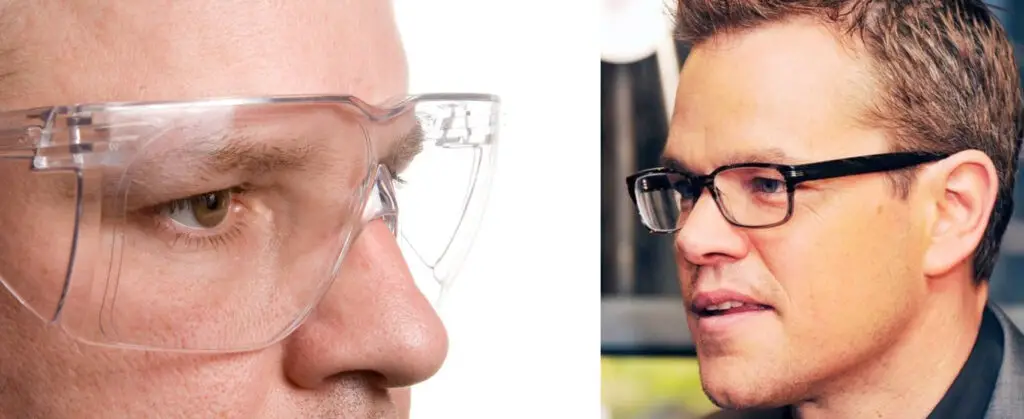When it comes to taking care of your eyes, protection is important. Whether you require glasses for your weak eyesight or for the safety of your eyes at work, you don’t want to compromise on the most delicate part of your body.
Safety glasses and regular glasses are not the same thing. On the job or at home, safety glasses are designed to give the best protection for your eyes. They’re designed to meet a greater standard of impact resistance than normal glasses. Lenses in safety glasses are far more protective to your eyes, whether or not they contain prescription lenses.
To put it another way, these lenses offer a better level of impact resistance than the lenses found in regular spectacles. Lenses used in safety glasses are not only more impact-resistant than regular glass lenses, but they are also lighter and scratch-resistant.
Since we all know that regular glasses are usually required to correct our weak eyesight or they’re just normal anti-glare glasses to protect your eyes from those long hours of staring at your computer screen or cell phones, but safety glasses are much tougher than that.

Read on to know about the differences between safety glasses and regular glasses. But first, let us understand which profession requires the use of safety glasses.
Safety glasses can and should be worn at all times in potentially hazardous environments, whether at work or at home.
If you work in an environment where your eyes are at risk, you should put on safety glasses. The following are some examples of professions who wear safety glasses on a regular basis:
→ Plumbers, because you can’t let filthy water or any toxic liquid get into your eye
→ Carpenters, because those small pieces of wood can be dangerous for the eyes
→ Laborers, because construction sites can be uncertain and dangerous
→ People whose work require using heavy machinery
Apart from the above mentioned points, you require safety glasses at home too because your eyes require additional protection in certain scenarios.
If you are renovating or fixing something at home, you will be using tools that are sharp and dangerous, therefore, you will require safety glasses in these situations for the protection of your eyes.
Difference between safety glasses and regular glasses
There are not many differences between the two, however, the few differences are quite important ones.
1.) Regular vs Safety Glass Lenses
To begin, one of the most noticeable distinctions between safety and ordinary glasses is the lenses. Lenses in safety glass are far more protective to your eyes, whether or not they contain prescription lenses.
The lenses of safety glasses are composed of a variety of materials, although polycarbonate is the most common.
Polycarbonate lenses are not only more impact-resistant than normal glass lenses, but they are also lighter than the regular ones.
2.) Safety Glasses Frame is more durable than Regular
The frames of safety glasses, like the lenses, are built to withstand a higher impact. They are put through tests to see how durable they are.
Regular glass frames are not built to withstand significant impact. There’s a good risk the frames will break if they fall off accidentally when you’re working in rough conditions.
While taking this risk may be worthwhile in your everyday life, it may be too hazardous if you plan on working or playing in a tough environment.
3.) Eye protection by Safety glasses
Safety glasses are eyewear that meets the OSHA and ANSI standards. Lenses must undergo a series of tests in order to meet ANSI requirements.
Non-impact-rated or impact-rated lenses and frames, as well as exposure to non-ionizing radiation and chemicals, must all be evaluated in safety glasses.
The ignition and corrosion resistance of safety eyewear is also checked. Safety glasses must also meet a minimum area of physical coverage to safeguard the wearer’s eyes in addition to these tests.
4.) How long do they last?
Well, your safety glasses will last upto 5 years if it has not been cracked, scratched or broken. And your regular glasses will last upto 2.5 years if there are no signs of damage.
See also: Do Safety Glasses Expire?
However, prescribed regular glasses need to be changed according to the changing eye number (power).
Just like how you need a Doctor’s advice and prescription to get eye glasses for your weak eyesight, in the same way, ANSI acts as a Doctor when talking about meeting the safety standards for protective eyewear. How to know if your safety glasses are ANSI approved?
The fundamental impact safety classification for lenses is determined by the drop ball test. A one-inch steel ball is dropped from a height of 50 inches onto the lens in this test. The lens passes the test if it does not fracture, chip, or break.
However, if it cracks, chips, or breaks, it may not be ANSI certified. This is one of a series of tests meant to determine a lens’s capacity to withstand severe pressure.
A high velocity test is performed in high impact testing by striking a ¼ diameter steel ball at the lens at 150 feet per second.
The lens should not fracture, shatter, or break, and it must not come loose from the lens holder in order to pass ANSI standard.
Some FAQs-
1.) Can you use regular glasses as safety glasses?
Your regular glasses cannot be used as protective, safety eyewear unless they are specifically designed to withstand certain impacts. Both glasses serve various purposes and have different capabilities.
Safety glasses must meet a greater requirement of impact resistance than regular glasses in order to be classified as a protective eyewear.
2.) How to maintain your safety glasses?
Your safety glass too requires a little care and regular maintenance. Here is a step by step way on how to clean and preserve your safety glasses.
How to clean them?
Read the instructions carefully. Cleaning should be done according to the manufacturer’s directions. When cleaning the lens, be careful not to scratch it. It can also cause the lens to become brittle.
How should you preserve your safety glasses?
Keep your safety glasses somewhere clean and dry where they won’t fall or be stepped on.
When to replace them?
Eyeglasses that have been scratched, cracked, bent, or that do not fit properly, should be replaced as soon as possible. Your ability to see is hampered by damaged eyewear. It’s also possible that the safety features will be compromised.
3.) Can you wear safety glasses on top of your regular glasses?
Many safety glasses are designed to fit over regular glasses, and they usually have extra space underneath for your regular glasses.
Best Recommended Safety Glasses
1.) DEWALT SAFETY Glasses
These non-slip, durable eyeglasses are a great choice or any rough, outdoor work where there are chances of things getting into your eye.
Check it out here-
- Rubber tipped temples provide a non-slip comfortable fit
- Full frame with larger lens provides excellent coverage
- Integrated rubber nosepiece for longer, comfortable wear
- Protects against 99. 9-Percent harmful UV rays
- Meets ANSI Z87. 1+ standards
Prices pulled from the Amazon Product Advertising API on:
Product prices and availability are accurate as of the date/time indicated and are subject to change. Any price and availability information displayed on [relevant Amazon Site(s), as applicable] at the time of purchase will apply to the purchase of this product.
2.) Strive Performance Safety Glasses
These comfortable protective wear are scratch resistant and are approved by ANSI, which means you don’t have to worry about the safety of your eyes even if you’re working in hazardous conditions.
Check it out here-
- COMFORT FIT: Comfort and security are our first priorities with the Strive tracer performance safety glasses. We designed them with built-in rubber-tipped temples to help ensure lasting comfort while working on long and strenuous projects
- WRAPAROUND LENSES: This is a stand out feature. The wraparound lenses are capable of protecting you from peripheral as well as direct debris threats.
- SCRATCH-RESISTANT: No lenses are scratch-proof but lenses that are treated on the front and back with a clear, scratch-resistant coating create a much harder surface that becomes more resistant to scratching from continuous use.
Prices pulled from the Amazon Product Advertising API on:
Product prices and availability are accurate as of the date/time indicated and are subject to change. Any price and availability information displayed on [relevant Amazon Site(s), as applicable] at the time of purchase will apply to the purchase of this product.
3.) MAGID Safety Glasses
These safety glasses come with side shields that not only protect your eyes from things that might hurt them from front, but also from objects that might hurt them from sideways.
You can check it out here-
- Magnification diopter is molded into the polycarbonate lens and designed for workers who have difficulty reading small print or who are engaged in small detail work
- Suitable for indoor/outdoor use; useful for extended screen time, lab work, manufacturing, and other applications
- Durable, yet lightweight black frame provides a comfortable fit; Sleek, retro appearance; Designed for women and men
Prices pulled from the Amazon Product Advertising API on:
Product prices and availability are accurate as of the date/time indicated and are subject to change. Any price and availability information displayed on [relevant Amazon Site(s), as applicable] at the time of purchase will apply to the purchase of this product.
Conclusion
There are not many differences between a regular eyeglass and a safety glass, however, the number of differences may be short but they are very significant.
Do not make the mistake of using your regular glasses in an environment where your eyes are at risk, this small mistake can cost a lot. You need proper protective gear for the safety of your eyes.
It is important to check the product before purchasing as safety glasses are supposed to protect the most delicate organ of your body.










